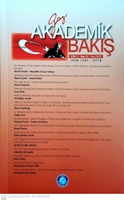XVII. Yüzyılda Osmanlı Hac Menzilleri: Rûznâmçeci İbrahim Efendi Kethüdâsı Hacı Ali Bey’in Tuhfetü’l-Huccâc Risâlesi Örneği
Ottoman Pilgrim-Stations in the 17th Century: The Sample of Tuhfetü’l-Huccâc as the Booklet of Hajj Ali Beg, Chamberlain of Clerk of the Daybooks Ibrahim Effendi
Author(s): Şerife Eroğlu MemişSubject(s): Social history, Islam studies, 17th Century, The Ottoman Empire
Published by: Gazi Akademik Bakış
Keywords: pilgrimage; pilgrimage route; pilgrimage guides; 17th century; Ottoman history;
Summary/Abstract: According to the Islamic belief, Muslims living in various regions, based on the principle of making every Muslim who is free, mentally healthy and entitled to make a pilgrimage at least once in their lifetime, have to live in Mecca in the first half of the month of Zilhicce. According to their distance from Mecca, they used to make their way to Mecca and Medina in crowded caravans days ago. The most ideal pilgrimage route for Anatolian Muslims was the Syrian caravan route. This road, consisting of Damascus-Amman-Karak-Ma‘an-Tebuk-Medain Salih- al-‘Ulâ and Medina line, was an important caravan route that dates back to ancient times and connects Hejaz to Syria, and therefore to Anatolia and Mesopotamia. It was connected to Istanbul and the Balkans through Adana-Konya-Akşehir andIznik in the west direction. Pilgrim candidates coming from these main roads and other secondary roads connecting Anatolia from north to south and east to west would join in Damascus and set out to go to Hejaz with the pilgrimage caravan created there.The study aims to examine the book of Tuhfetu’l-Huccâc which is a pilgrimage guide that deals with the characteristics of places of accommodation, cities and places of visit along the road from Uskudar to Damascus and from Mecca and Medina, as well as the conditions of the pilgrimage and the duties to be fulfilled in pilgrimage. Hajj Ali Beg described the places and conditions of the pilgrimage and asked to present a collective index and guide to the Muslims who intend to pilgrimage. In this context, the study consists of three parts. First of all, the author of the work will be briefly introduced. In the second part,the subject and parts of the work will be examined in terms of language and spelling features, the reasons for their writing and their content. In the third section, by comparing with similar studies, it will be tried to analyze what Hajj Ali Beg said different about the period of his work.
Journal: Gazi Akademik Bakış
- Issue Year: 13/2020
- Issue No: 26
- Page Range: 267-298
- Page Count: 32
- Language: Turkish

